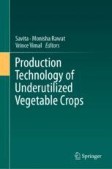Search
Search Results
-
Production Technology of Underutilized Crops of Compositae Family
The Asteraceae (Compositae) family includes nearly 13,000 species, primarily herbaceous plants, and some trees, shrubs, and vines. It comprises...
-
The sunflower plant family for bioenergy, environmental remediation, nanotechnology, medicine, food and agriculture: a review
Energy security and pollution are becoming critical issues in the context of climate change and the circular economy, calling for sustainable...

-
Microbial Production of Polysaccharides, Oligosaccharides, and Sugar Alcohols from Vegetables and Fruit Wastes
The use of agricultural wastes and by-products as substrate to produce polysaccharides, oligosaccharides, and sugar alcohols has gained interest in...
-
Use of Chemical Mutagens in Field Crop Breeding
Factors such as abiotic and biotic stress, pests, diseases, and climate change can affect the morpho-physiological and biochemical status of the...
-
Adsorption of anionic and cationic dyes in aqueous solution by a sustainable and low-cost activated carbon based on argan solid waste treated with H3PO4
The objective of this work is to study the adsorption capacity of a natural and low-cost material prepared from argan waste treated with H 3 PO 4 ...

-
Heavy Metal Removal Using Plant Origin Biomass and Agricultural Waste-Derived Biomass from Aqueous Media: a Review
The effectiveness of natural low-cost plant-based biomass and agricultural waste in order to remove the iron, aluminum, copper, and other heavy...
-
A review on constructed wetlands for environmental and emerging contaminants removal from wastewater: traditional and recent developments
The water crisis is a global problem. According to estimates, at least one month of significant water scarcity impacts four billion people, or over...

-
Catalytic Production of High-Value Chemicals from High Volume Non-food Biomass
Growing population and energy crises with depletion in fossil resources have necessitated efforts to find a sustainable solution. With circular...
-
Removal of Toxic Chemicals from Air Through Phytoremediation
As a result of the increased population together with various anthropogenic activities, such as agriculture, swift urbanization and...
-
Exposure assessment for pesticide residues in agricultural products consumed in the Republic of Korea during 2016–2020
Pesticide residues in food comprise compounds such as insecticides, fungicides, herbicides, miticides, and plant activators. The insecticides...

-
Smart Farming Technologies for Sustainable Agriculture: From Food to Energy
Sustainable agriculture covers environmentally friendly farming methods that preserve an ecological balance by avoiding depletion of natural...
-
Molecular characterization of Helianthus tuberosus L. treated with ethyl methanesulfonate based on inter-simple sequence repeat markers
Mutation breeding is one of the most effective techniques in plant breeding. Mutagens are used to induce variation in plants. Ethyl methanesulfonate...

-
Continuous crop** of alfalfa (Medicago sativa L.) reduces bacterial diversity and simplifies cooccurrence networks in aeolian sandy soil
Alfalfa is a perennial herbaceous forage legume that is remarkably and negatively affected by monocrop**. However, the contribution of the changes...

-
Pyrolysis Temperature-Dependent Changes in the Characteristics of Biochar-Borne Dissolved Organic Matter and Its Copper Binding Properties
The dissolved organic matter (DOM) samples from biochars produced from Jerusalem artichoke stalks by pyrolysis at 300, 500, and 700 °C were...

-
Recent developments on sustainable biobutanol production: a novel integrative review
Renewable and sustainable biofuel production, such as biobutanol, is becoming increasingly popular as a substitute for non-renewable and depleted...

-
Biochar Adsorbents for Arsenic Removal from Water Environment: A Review
Arsenic intake can cause human health disorders to the lungs, urinary tract, kidney, liver, hyper-pigmentation, muscles, neurological and even...

-
Acrylamide in bread: a review on formation, health risk assessment, and determination by analytical techniques
Acrylamide is a water-soluble toxicant found in high-protein and carbohydrate-containing foods exposed to high temperature like bread as the staple...

-
Potential Agricultural Use of Reject Brine from Desalination Plants in Family Farming Areas
After droughtDrought, salinitySalinity is the second most important hindrance to sustain agricultureAgriculture in the semiarid. Subterranean waters...
-
Pyrolyzed biomass-derived nanoparticles: a review of surface chemistry, contaminant mobility, and future research avenues to fill the gaps
Nanoparticles are abundant in the subsurface, soil, streams, and water bodies, and are often a critical control on elemental speciation, transport...

-
Biochar derived from chicken manure as a green adsorbent for naphthalene removal
In this study, biochar was generated from chicken manure by using a tube furnace under different temperatures (300, 500, and 700 °C), and the...

